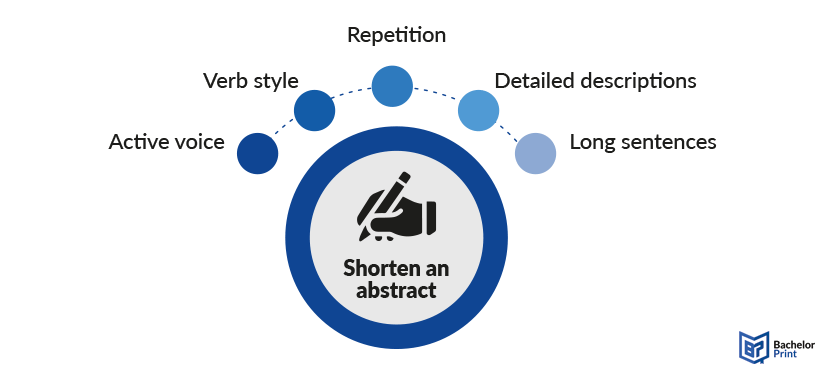
Students that aim for a doctorate or master’s degree in academia sometimes exceed the word limit while writing abstracts for their dissertations because they use too many complex phrases or wording. Attempting to reduce the abstract to a manageable length often presents many challenges, as the original context and logic can easily be lost in the process. The purpose of this article is to provide students with pointers on how to shorten an abstract.
Definition: Shorten an abstract
The abstract is a summary of your thesis, depending on the requirements of your university, between 150 and 500 words. It should include all relevant insights of your research in a short and compact manner. There are a few tips on how to shorten an abstract if it ended up longer than needed. These include writing active sentences instead of passive voice, using verb style, keeping the sentences short and easy to understand and removing detailed descriptions.
- ✓ 3D live preview of your individual configuration
- ✓ Free express delivery for every single purchase
- ✓ Top-notch bindings with customised embossing


Use active sentences
The passive voice oftentimes seems to sound more academic because we do not use it in our daily conversations very often. However, passive sentences are a lot longer than active ones, so changing the grammatical voice of your sentence helps you shorten an abstract. To change one form into the other, you have to change the order of words, so that the acting person is the center of attention and not the action itself. The following table will show you a few example sentences.
Use verb style
Just as the passive voice, the noun style also seems more eloquent and academic. But it also lengthens your text, and some teachers and professors might want you to avoid it completely. Changing noun style into verb style will not only shorten an abstract, but may also give your text more variety in phrasing because you do not need to rely on the same verbs over and over to support these nouns.
Avoid repetitions and complex sentences
Many students like to use flowery language and complicated structures in an abstract. Therefore, cutting out unnecessary words that lengthen sentences may be helpful to shorten an abstract of a dissertation.
- Avoid using the same words or phrases multiple times.
- Reread the abstract aloud once it has been completed, it will assist you in dealing with repeated phrases and vocabulary.
- Ask friends or family members to read your text and maybe spot the recurrence of sentences, words, or phrases.
- Also use computer tools to detect verb or sentence repetition.
Avoid detailed descriptions
The abstract does not need to include detailed background information about your topic, as it will be explained throughout your whole thesis. This is why you can exclude most details to shorten an abstract. However, you should still watch out to be clear and specific in the topics you do write about in the abstract, so there are no misunderstandings.
Avoid long sentences
As an abstract mostly has a defined length set by university standards, it is important to keep the word count in mind. This is why you should avoid long sentences or phrases to elongate a text. The following examples will show you how to cut down words and shorten an abstract.
FAQs
Typically, to shorten an abstract in a thesis or dissertation entails condensing them between 150 and 300. Often, a hard work limit must be adhered to, so be sure to verify with your institution’s guidelines.
To shorten an abstract, you can change passive voice to active and noun style to verb style. Moreover, you can check for unnecessary repetitions, long sentences or detailed descriptions, that are not needed in the abstract.
The abstract is the summary of your thesis or dissertation. This is why it is supposed to be short and concise. For a more detailed information, you should ask your trusted advisor about how many words are recommended at your university. As many students tend to write too much into their summary, however, it may be necessary to shorten an abstract.
